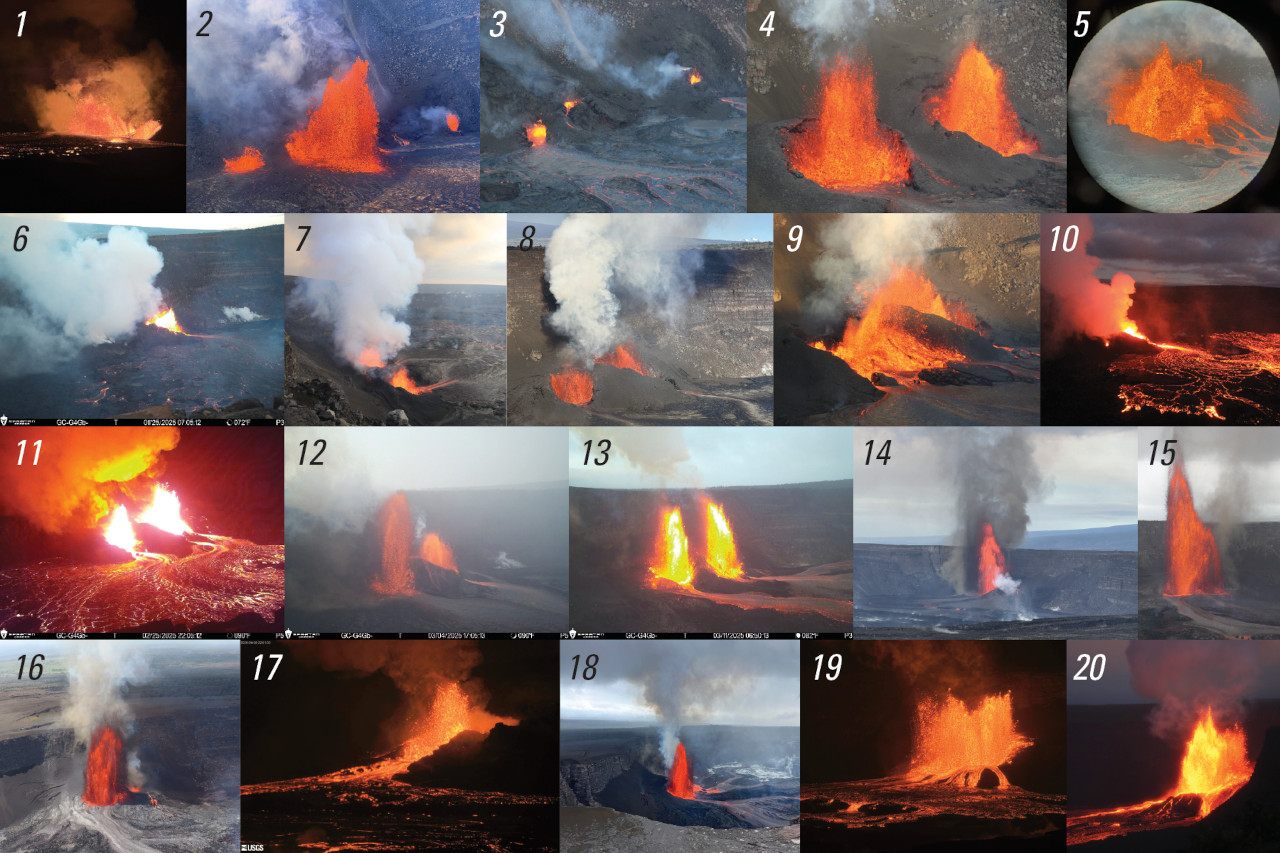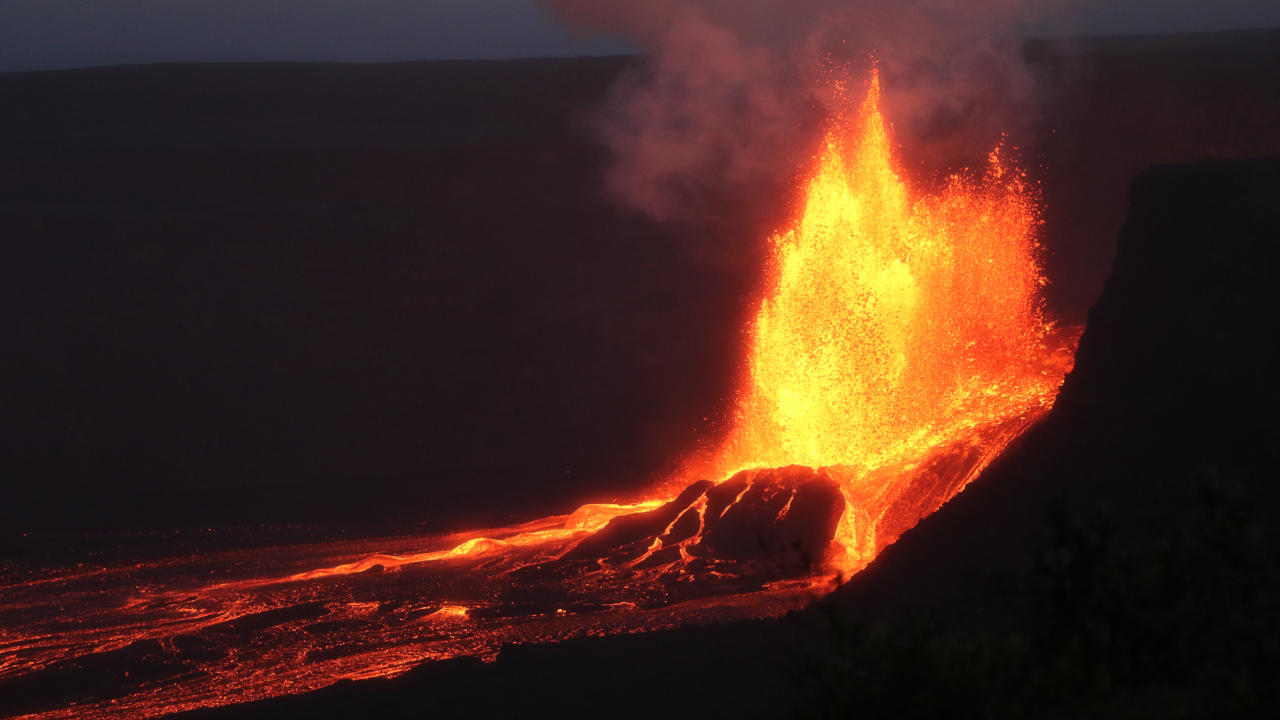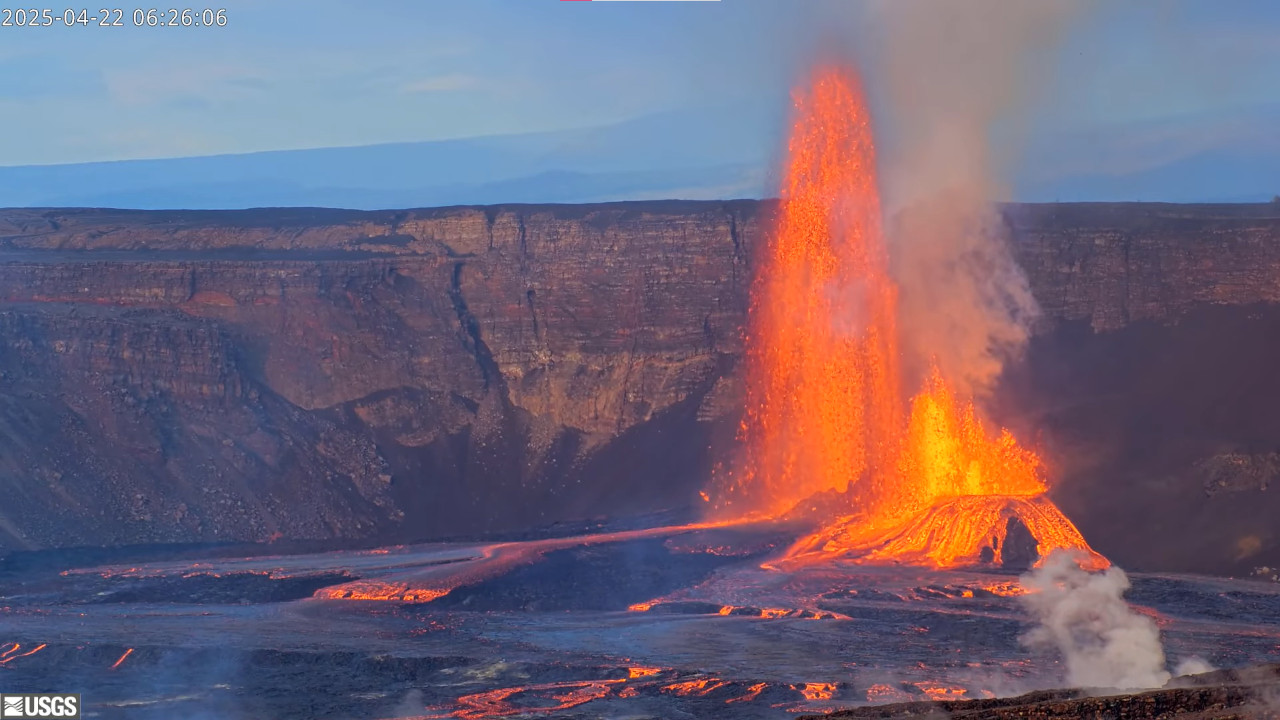(BIVN) – The eruption at the summit of Kīlauea remains paused, although the signs of the next volcanic episode are already visible on webcams.
Overnight, “prominent flames and intermittent spatter” could be seen at the north vent after 7 pm HST. “Flames were also seen prior to episode 19 and in January,” the USGS Hawaiian Volcano Observatory commented. “Yellowish flames in volcanic vents are due to burning of hydrogen gas.”
In this week’s Volcano Watch article, HVO geologists Drew Downs and Natalia Deligne take a look back at the previous 20 episodes of the current eruption. They write:
On December 23, 2024, eruptive activity at Kīlauea’s summit began again with the first in what has become 20 discrete lava fountaining episodes. Many episodes have had dual fountains—two erupting at the same time—a rare occurrence at Kīlauea and worldwide. The most recent episode 20 concluded at 9:28 p.m. H.S.T. on May 6, 2025.

USGS: “Photo compilation of episodes 1–20 of the ongoing eruption at the summit of Kīlauea, including webcam imagery and photos taken by USGS Hawaiian Volcano Observatory scientists on the ground and during helicopter overflights. In all photos except for episode 7, the south vent is on the left and the north vent is on the right. For the episode 7 photo, the north vent is in the center and the south vent is below it to the right.”
Sustained lava fountaining, sometimes to impressive heights, have awed the crowds that have flocked to Hawaiʻi Volcanoes National Park to view the episodes—along with those watching from home on two USGS Hawaiian Volcano Observatory livestreams (V1cam and V2cam). The duration of semi-regular lava fountaining has ranged from around 4.5 hours (episode 20) to as long as 8.5 days (episode 3). However, many (11 of the 20) of the fountaining periods have lasted less than 24 hours. Once sustained lava fountains begin, they usually reach heights of 100–350 ft (30–100 m) above the vents. The highest fountains yet measured during these episodes reached over 1,000 ft (300 m) during episodes 15 and 16 in March and April 2025.
These lava fountains have fed lava flows, some more extensive than others, that have collectively continued to fill the crater formed during the 2018 summit collapse. In some places near the vents, the lava flows are nearly 200 ft (60 m) thick, and they have covered 816 acres (330 hectares).
Repose intervals—or the pause times between episodes—have ranged from 16 hours to 12 days. Intermittent spattering and occasional lava flows have occurred between episodes, as happened twice during episode 18 when lava flows issued from the vents for a few hours, a few days prior to lava fountains commencing.
These impressively high lava fountains have produced tephra (fragments of lava) and Pele’s hair (fibers of volcanic glass). The distribution of tephra is controlled by prevailing wind patterns, with fallout zones downwind of the vents. Trade winds blowing to the southwest are most common, and this has resulted in tephra accumulating in the closed area of Hawaiʻi Volcanoes National Park to thicknesses that can reach greater than 6.5 ft (2 m). During slack and Kona winds, tephra and Pele’s hair have fallen on the summit region around Volcano village, the Volcano Golf Course, and along Highway 11 near Nāmakanipaio campground.
Almost all eruptive activity has been sourced from two vents at the base of the western wall of Halemaʻumaʻu crater within Kaluapele (the summit caldera). These are referred to as the north and south vents, and they have alternated in dominance during episodes. At times the south vent has generated spectacular lava fountains that have reached over 1,000 ft (300 m) tall, whereas the north vent has primarily exhibited low‑level spattering or lava ponding, but there have been reversals of this pattern. Since episode 14, gas pistoning—the rhythmic rise and fall of the lava column—has been observed within both vents prior to fountaining by hours to a full day, and it is usually visible in the V1cam livestream.
Each episode of high lava fountaining coincides with the onset of sharp deflation at the summit. Pre-fountaining inflation at UWD and SDH tiltmeters, used to measure inflationary and deflationary signals near Uēkahuna and to the south of Kaluapele, gives way to rapid deflation. At the same time, seismic tremor increases rapidly as more fluid moves through the conduits to erupt from the vents. A rapid turnaround from deflation to inflation and drop in seismic tremor marks the end of an episode.

USGS: “Late in the evening on April 1, USGS Hawaiian Volcano Observatory geologists watched the ongoing Kīlauea summit eruption from Kūpinaʻi Pali (Waldron Ledge). This view of the active eruptive vents was captured through the lens of a laser rangefinder device the geologists were using to measure lava fountain heights.” (USGS photo by M. Zoeller)
These spectacular lava fountains have been easily visible from many of the publicly accessible overlooks within Hawaiʻi Volcanoes National Park. Even so, hazards persist during volcanic activity for those visiting to enjoy the sights. Shifting winds blow around elevated concentrations of volcanic gases, particularly strong-smelling sulfur dioxide (SO2), and tephra and Pele’s hair that are mostly comprised of volcanic glass. The gases and small glassy particles can irritate respiratory systems, and Pele’s hair can form splinters under the skin.
As the summit of Kīlauea continues its lava fountaining episodes, HVO will maintain its continuous monitoring and livestreaming to document the eruption’s evolution, inform hazard assessments, and apprise the public of ongoing volcanic activity.



by Big Island Video News6:27 am
on at
STORY SUMMARY
HAWAIʻI VOLCANOES NATIONAL PARK - Scientists look back at the episodic pattern of eruptive activity at the summit since December 2024.